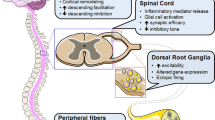Summary
The physiology of nociception involves a complex interaction of peripheral and central nervous system (CNS) structures, extending from the skin, the viscera and the musculoskeletal tissues to the cerebral cortex. The pathophysiology of chronic pain shows alterations of normal physiological pathways, giving rise to hyperalgesia or allodynia. After integration in the spinal cord, nociceptive information is transferred to thalamic structures before it reaches the somatosensory cortex. Each of these levels of the CNS contain modulatory mechanisms. The two most important systems in modulating nociception and antinociception, the N-methyl-D-aspartate (NMDA) and opioid receptor system, show a close distribution pattern in nearly all CNS regions, and activation of NMDA receptors has been found to contribute to the hyperalgesia associated with nerve injury or inflammation. Apart from substance P (SP), the major facilitatory effect in nociception is exerted by glutamate as the natural activator of NMDA receptors. Stimulation of ionotropic NMDA receptors causes intraneuronal elevation of Ca2+ which stimulates nitric oxide synthase (NOS) and the production of nitric oxide (NO). NO as a gaseous molecule diffuses out from the neuron and by action on guanylyl cyclase, NO stimulates in neighboring neurons the formation of cGMP. Depending on the expression of cGMP-controlled ion channels in target neurons, NO may act excitatory or inhibitory. NO has been implicated in the development of hyperexcitability, resulting in hyperalgesia or allodynia, by increasing nociceptive transmitters at their central terminals. Among the three subtypes of opioid receptors, μ- and δ-receptors either inhibit or potentiate NMDA receptor-mediated events, while κ opioids antagonize NMDA receptor-mediated activity. Recently, CRH has been found to act at all levels of the neuraxis to produce analgesia. Modulation of nociception occurs at all levels of the neuraxis, thus, eliciting the multidimensional experience of pain involving sensory-discriminative, affective-motivational, cognitive and locomotor components.
Zusammenfassung
Die Physiologie der Schmerzwahrnehmung beruht auf einer komplexen Interaktion peripherer, spinaler und supraspinaler Strukturen des Zentralnervensystems (ZNS). Auf jeder Ebene des ZNS erfolgt eine Modulation nozizeptiver Information, wobei die zwei wichtigsten Transmittersysteme der Nozizeption und der Antinozizeption, das N-methyl-D-aspartate (NMDA)- und das Opioid-Receptor System, eine nahezu identische Verteilung zeigen. Glutamat, der natürliche exzitatorische Transmitter aller Neurone mit ionotropen NMDA-Rezeptoren, bewirkt durch Öffnen des Ca2+-Kanals über die damit verbundene Aktivierung der intraneuronalen Stickoxidsynthase die Freisetzung von Stickoxid (NO). Diffusion des NO in Nachbarneurone erhöht deren cGMP-Synthese verbunden mit einer erhöhten neuronalen Aktivität, welche sich als Hyperalgesie oder Allodynie äußert, wenn Transmitter aus nozizeptiven Nervenendigungen freigesetzt werden. Die periphere Sensibilisierung nozizeptiver Axone erfolgt meist über Serotonin, Bradykinin oder Prostaglandine. Während die μ- und δ-Opioid-Rezeptoren die NMDA-Rezeptor vermittelte Nozizeption hemmen oder verstärken, antagonisieren κ-Opioide NMDA-Rezeptor vermittelte Reaktionen vollständig. Hingegen wirkt Corticotropin-relasing-Hormon auf allen Ebenen des ZNS antinozizeptiv.
Similar content being viewed by others
Author information
Authors and Affiliations
Rights and permissions
About this article
Cite this article
Riedel, W., Neeck, G. Nociception, pain, and antinociception: current concepts. Z Rheumatol 60, 404–415 (2001). https://doi.org/10.1007/s003930170003
Issue Date:
DOI: https://doi.org/10.1007/s003930170003




